Do you live in the same place where you were born, or where you spent most of your growing-up years? As a culture, we have a reputation for being pioneers. Wanderers. Restless spirits ready to conquer the great unknown But in truth, nearly half of Americans live in the same community where they grew up. (According to the Pew Research Center, that number goes up if you live in the Midwest; on the west coast, that number goes down.)
There are lots of reasons why people stay put or move on; family connections and economic opportunity top those lists. My dad once explained it this way: “You either decide where you want to live and find work there, or you decide what job you want and go where you need to.”
For the most part, I think he was right about that. I’ve lived in five different states and six communities; I made every one of those moves in the service of my career. And I came to Texas thinking it would be another one of the many places that career would take me.
But one thing I’ve learned: some places stick. Others don’t. It didn’t take long to discover that San Antonio was one of those sticky places.
The town where I grew up, on the other hand, was not. I knew that from the time I was fairly young. I can’t tell you when–I didn’t have a big epiphany, a moment when I realized this wouldn’t be where I lived out my life. And I did, of course, have moments of planning a future there. It’s hard to imagine a future anywhere else when you’ve lived in one house as far as memory serves, in one town since you were a toddler.
I don’t have negative feelings about that place. But I know it’s not where I belong.
Geographer Yi-Fu Tuan gets at these feelings in his book Space and Place. He talks about the idea of topophilia–the bond between people and places–and suggests that, when it develops, this bond is more complex than we might realize. It’s not just a general place that we fall in love with: it’s particular details. Smells, for instance. Or specific visual features, like native plants and seasonal changes. All these things, once they become recognizable, can make a place feel familiar and manageable–or predictable and oppressive, if that bond never takes shape.
I started thinking about these things last week, when Mike told me that someone had stopped him on his dog walk to ask the name of the flowering trees in our neighborhood. I remember being a newcomer and not knowing the name crape myrtle. I remember not knowing that live oaks lose their leaves in the spring, rather than in the fall, like other deciduous trees. And, I remember not knowing that it’s possible for summer weather to settle in as early as March. No one gets too excited about an early spring warm-up once they know those temperatures might hold until October. Or November.
The tagline for this blog is Bloom where you dwell. I mean that to be a response to the people who tell you to Bloom where you’re planted. Dwell is a verb. It requires intention. When we dwell, we don’t just take up space; we choose a place.
You can certainly blossom in your hometown, surrounded by the extended family that one of your ancestors planted there some years ago. As I noted at the start of this post, lots of people do exactly that. And many of my students, as they graduate from college and move on to graduate school and professional careers, tell me they plan to stay in this area. If this is the place they love, that makes perfect sense to me.
But it’s empowering to remember that staying in place is a choice. It might not feel that way; you might be thinking My whole family has lived here for generations–where else would I go? If living near family is your priority, then moving–or, moving very far–might be an option you aren’t willing to consider. Declining to answer to that question is a choice you can own.
When I decided to leave my hometown, I left with whatever I could pack into the aging car I drove across the country. I was lucky that my father had begun his adult life in the military; he understood that, sometimes, leaving home is the only way forward. Even if you’re leaving a home where people really love you and wish you would stay.
I drove from Idaho to Kansas, where I knew no one. I started graduate school at a university where I’d never set foot until my first day in town. None of this seemed extraordinary, at the time. I was just doing what felt right.
And as it turns out, that was just the first leg of a very long journey. It brought me to where I am now–dwelling in the place where I belong.





No Comments